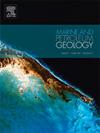硫酸盐热化学还原生成轻烃的地球化学特征:三组模拟实验结果
IF 3.7
2区 地球科学
Q1 GEOSCIENCES, MULTIDISCIPLINARY
引用次数: 0
摘要
热化学硫酸盐还原(TSR)是一种强烈的氧化还原反应,它显著改变了深层储层中的原始烃。已有研究表明,轻烃(LHs)在TSR的某些阶段可以作为重要产物生成。然而,这些tsr衍生的LHs的地球化学特征研究仍然很少,它们与热裂解生成的LHs (tc衍生的LHs)的差异尚不清楚。设计一种不受TC影响而产生LHs的TSR仿真可以解决这一问题。本研究以正十八烷、正十二烷基苯和重油为初始烃反应物,在密封金管中进行了三个TSR系列实验。系统地分析了合成的LHs的产率、分子组成和碳同位素特征。结果表明,tsr衍生的轻质油收率相当高(243.90 ~ 326.48 mg/g HCs),与TC大致相当。然而,tsr衍生的LHs的生成过程明显提前,并且发生在相对于TC的较低期限。在分子组成方面,TSR促进了正构烷烃和芳烃的生成,同时抑制了支链烷烃和环烷烃的生成。这导致tsr衍生的LHs的组成特征与tc衍生的LHs不同。此外,随着TSR的进展,TSR衍生的LHs在13C中越来越富集。观察到的富集程度(3.7‰~ 6.2‰)大于tc衍生LHs (<3‰),但小于TSR蚀变LHs,其中大部分被TSR蚀变破坏(3 ~ 22‰)。tsr衍生LHs的大部分地球化学参数不能提供关于生物输入、沉积环境、成熟度或后期蚀变的可靠信息。因此,在可能发生TSR的深层储层中,应谨慎使用这些参数。此外,初始烃的组成影响了tsr衍生烃的生成。初始烃的长链石蜡基团在TSR后期断裂并逐渐演化为LHs,而芳烃环的出现导致了早期富芳烃LHs的生成。tsr衍生的轻质油是一种新的油气资源,但其经济性不如tsr原油。该研究增强了我们对tsr衍生陆相的生成、演化和典型地球化学特征的认识,为深部盆地轻质油资源评价提供了有价值的见解。本文章由计算机程序翻译,如有差异,请以英文原文为准。
Geochemical characteristics of light hydrocarbons generated in thermochemical sulfate reduction: Results from three series of simulation experiments
Thermochemical sulfate reduction (TSR) is an intense redox reaction that significantly alters the original hydrocarbons in deep reservoirs. Previous studies have shown that light hydrocarbons (LHs) could be generated as important products in certain stages of TSR. However, the geochemical characteristics of these TSR-derived LHs remain poorly investigated, and their differences from those of LHs generated by thermal cracking (TC-derived LHs) are unclear. A TSR simulation designed to generate LHs without the influence of TC can solve this problem. In this study, three TSR series were conducted using n-octadecane, n-dodecylbenzene, and heavy oil as initial hydrocarbon reactants in sealed gold tubes. The yield, molecular composition, and carbon isotopic characteristics of the generated LHs were systematically analyzed. Results indicated that the yield of TSR-derived light oils was considerable (243.90–326.48 mg/g HCs), broadly equivalent to that in TC. However, the generation process of TSR-derived LHs was significantly brought forward and occurred at lower maturities relative to TC. In terms of molecular composition, TSR facilitated the formation of n-alkanes and aromatics, while suppressing the generation of branched alkanes and cycloalkanes. This resulted in the compositional characteristics of TSR-derived LHs being distinct from those of TC-derived LHs. Additionally, TSR-derived LHs became increasingly enriched in 13C as TSR progressed. The observed enrichment (3.7 ‰–6.2 ‰) was greater than that in TC-derived LHs (<3 ‰) but smaller than that in TSR-altered LHs, most of which were destroyed by TSR alteration (3–22 ‰). Most geochemical parameters of TSR-derived LHs did not provide reliable information on biological inputs, depositional environment, maturity, or later alteration. As a result, these parameters should be used cautiously in deep reservoirs where TSR is likely to occur. Moreover, the composition of the initial hydrocarbons influenced the generation of TSR-derived LHs. The long-chain paraffin group from the initial hydrocarbons breaks off and gradually evolves into LHs during the later stages of TSR, whereas the occurrence of aromatic rings leads to the earlier generation of aromatic-rich LHs. TSR-derived light oils represent a new hydrocarbon resource in deep basins, although they are less economical than TSR-unaltered oils. This study enhances our understanding of the generation, evolution, and typical geochemical characteristics of TSR-derived LHs, and offers valuable insights for evaluating light oil resources in deep basins.
求助全文
通过发布文献求助,成功后即可免费获取论文全文。
去求助
来源期刊

Marine and Petroleum Geology
地学-地球科学综合
CiteScore
8.80
自引率
14.30%
发文量
475
审稿时长
63 days
期刊介绍:
Marine and Petroleum Geology is the pre-eminent international forum for the exchange of multidisciplinary concepts, interpretations and techniques for all concerned with marine and petroleum geology in industry, government and academia. Rapid bimonthly publication allows early communications of papers or short communications to the geoscience community.
Marine and Petroleum Geology is essential reading for geologists, geophysicists and explorationists in industry, government and academia working in the following areas: marine geology; basin analysis and evaluation; organic geochemistry; reserve/resource estimation; seismic stratigraphy; thermal models of basic evolution; sedimentary geology; continental margins; geophysical interpretation; structural geology/tectonics; formation evaluation techniques; well logging.
 求助内容:
求助内容: 应助结果提醒方式:
应助结果提醒方式:


